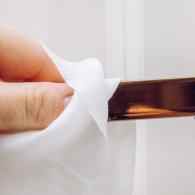Disinfectants with residual disinfectant efficacy, commonly called Long-Lasting Disinfectants, are an emerging product trend.
In this article, we list the potential benefits and limitations when using this technology for the disinfection of high-touch surfaces in different facilities.
The importance of high touch areas cleaning
Hard non-porous surfaces in public facilities may play a role in the transmission of pathogenic microorganisms, causing infections in people. Environmental surfaces that receive the most hand contact, such as door handles, elevator buttons, light switches, counters, and touchscreens, may be at higher risk of helping to transfer microorganisms, thereby leading to infection.
Normal disinfectants intended for hard non-porous surfaces are an important part of providing a hygienic environment in public facilities. The cleaning process removes soils and microorganisms, and the disinfection process kills or inactivates remaining microorganisms. However, while disinfectants are highly effective at addressing risks associated with soils and microorganisms, they are only effective when used, as they provide immediate efficacy but no ongoing residual efficacy on surfaces.

Reduce the risk of cross-contamination
Once the surface cleaning and disinfection are completed, subsequent contamination of the surface creates a hygiene risk for people coming into contact with the surface. To address this limitation, a range of chemical products have been proposed which are applied to the surface on a regular basis and provide continued efficacy between cleaning and disinfection events. These products are referred to as having residual efficacy.
Residual efficacy reduces the hygiene risk for surfaces contributing to infection by continually protecting the surface with active biocides compounds, while the best-in-class disinfectant just gives immediate efficacy.
Long-lasting disinfectant technologies available
One approach to delivering residual efficacy is to incorporate the biocidal agent into the surface during manufacturing. Door handles, railings, and light switches made from copper alloys or containing biocidal agents have been proposed, although these technologies are not discussed in this article.
The other, more common approach is to provide the facility with a product that can be applied to environmental surfaces on a regular basis that includes the biocidal agent (typically a quaternary ammonium chloride compound or a chlorine-releasing compound) and may also include a removable film (siloxane polymer or polyvinyl alcohol) or another agent to help attach the biocidal agent to the surface.
Diversey recently launched a product powered by innovative advanced polymer technology (APT) based on a polymer-binding film. The film provides a reservoir of quat near the surface, meaning that over the next 24 hours, any contamination of the surface is exposed to a fresh supply of biocidal quat. Through this mechanism, the surface retains the antimicrobial ability, limiting microbial contamination between applications of the product.
Curious to discover Diversey long-lasting disinfectant?
Have a look at this video.
Main criteria for selecting a long-lasting disinfectant
1. Impact on disinfection efficacy
The degree to which the polymer film holds the biocidal agent is a key factor in determining the bioavailability of the solution. Bioavailability measures the amount of the biocidal agent that is capable of attacking microorganisms.
Residual solutions that strongly hold the biocidal agent provide low bioavailability and while they may be active over a long period of time, they provide relatively low efficacy because of the low bioavailability of the biocidal agent and when surface soiling occurs, the soil can provide a barrier to efficacy. Residual solutions that loosely hold the biocidal agent provide higher levels of efficacy, but are effective over a shorter period of time and are less impacted by surface soiling.
2. Surface aesthetics and abrasion
The disinfectant should be mild to surfaces and compatible with materials commonly found in commercial facilities. The polymer layer/film needs to be easily removable by cleaning products but needs to resist removal by abrasion.
3. Antimicrobial efficacy
The PAS 2424 test method, developed by the British Standards Institute is one of the most recognizable efficacy testing methods in Europe. It requires multiple abrasion cycles and multiple reinoculations and has a 3-log reduction target.
Efficacy can be described as ‘cidal’, meaning that it kills or inactivates the microorganism to the standards set by government regulators to be a registered disinfectant; or ‘static’, meaning that it only provides a benefit in preventing the reproduction of microorganisms.
Residual efficacy disinfectant provides disinfectant efficacy when the product is applied, sanitizing efficacy over the next 24 hours, and a ‘static’ residual effect over the same 24-hour period. This efficacy applies to a wide spectrum of gram-positive and gram-negative bacteria, yeasts, and enveloped viruses, as should be shown on the product label.
Conclusion
Products that deliver residual disinfectant efficacy are ideal to the treated surfaces and high-touch, non-food contact surfaces to provide biocidal efficacy between routine disinfection events.





